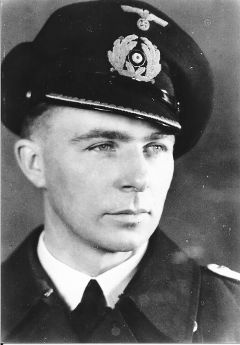Discovery of Doris
by Ton van der Sluijs
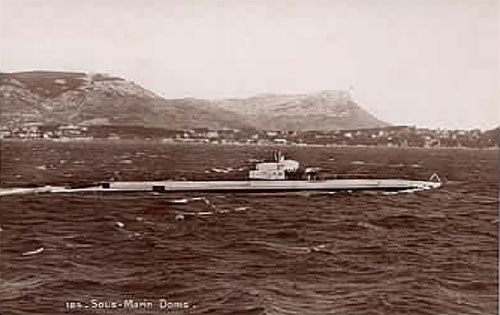
The French submarine Doris on the surface
History of Doris
The French submarine Doris started her long life as a keel plate in a shipyard in Toulon in France in 1923, on a cold January morning. Four of them were built at the same time. They were of the "Thetis" class (info), named after one of the ships. The other two were named Circé and Calypso.
They were ready for operation in 1927. In the years before the Second World War, nothing significant happened and many crews had served on them and left them peacefully. However, in 1939 when Hitler showed his intensions to the world, a number of French navy ships were loaned to the British navy and the submarine Doris was one of them.
At the end of April 1940 Doris and other French submarines were called to Harwich, England for new assignments under British command. A couple of hundred miles from their destination the engine that operated the main compressor seized. This compressor supplied the air necessary for Doris to ascend after a dive. It was impossible to repair it, so they limped towards Harwich on one engine.
The navy technicians in Harwich could not repair the broken engine and they could not even obtain a replacement in France. In 1927 the French had bought the boat engines in Germany at Schneider Diesels. They did this because the Germans built the most compact and powerful diesels compared to some other French makes. They must have been too proud to even consider buying them from England.
On May 6th 1940 all the crews were informed that they would go on patrol on the North Sea, above the Frisian Islands to keep an eye on the German fleet and their movements. Even submarine Doris would join that task although she wasn't fit for it; she could only sail at half speed and in an emergency she could dive but could never ascend afterwards! That meant that she was the "sitting duck" of the submarine group and if her luck should end, the crew could only pray for a miracle.
The Commander at the base took the crew aside and told them that the task they were assigned was important enough that they would have to go out with the broken engine. He also told them that he did not expect that they would survive this mission. He also asked them if there were any quitters amongst them. The crew of submarine Doris looked at each other and most of the crewmen responded loudly. They decided that they had come this far as one family and they would serve France and the free world as one and if they had to die, then they would do so together. No one refused the job.
That night everybody took the time to write a farewell letter, the tears still falling on the wet ink of their letters. (When Hans and I did meet the relatives, a lot of them showed us the original letters of goodbye and Lilliane Sylverstre, granddaughter of the first engineer Maurice Le Sceller, translated some of them for us).
On the early morning of May 8th 1940, when the group of ships sailed out of Harwich, submarine Doris was among them. The group consisted of British submarines Sturgeon, Shark, Seawolf, Snapper and Triad and French submarines Arphée (?), Calypso, Antiope, Circé, La Sybylle, Thétis and finally Doris. Their mission was to guard the east entrance to the English Channel, off the Dutch Coast in anticipation of German invasion of England. The whole day was a fine sunny day and no cloud was seen in the sky. When darkness came the men on watch were at their posts.
Roughly two miles away was another submarine. It was the U-9, under the command of 26 year old Oberleutnant zur See Wolfgang Lüth. He followed the group the whole day and waited until darkness to prepare for his attack. At 1 AM he took up his attack position and with a big blue moon behind submarine Doris she was the easiest sitting duck he ever could imagine.
Lüth approached her and at close range he gave the order to fire two torpedoes at her. According to the war diary of U-9, there was a 100 meter high fireball and within only one minute the French submarine Doris had disappeared. (Lüth gave the position as 53.40.00N x 3.50.00E; we discovered her at 52.47.36N x 3.49.16E).
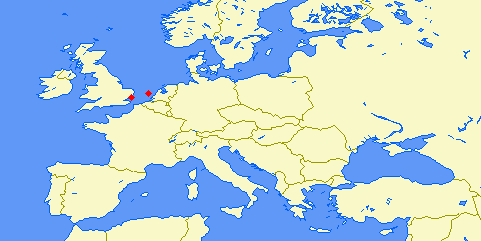
Map show departure from Harwich on May 8 and her loss on May 9
Discovery of Doris
Doris was discovered by Dutch divers Hans van Leeuwen and Ton van der Sluijs in 2003 in the North Sea at position 52.47.36N x 3.49.16E. Here follows their account.
It all started with a look at the sea chart of the North Sea; a green spot on the map told us that there was an obstruction in the seabed, but what? Hans van Leeuwen answered with "the weather is fine Saturday; let's have a look!". So Saturday we departed from the harbor at 3:00AM and sailed for 6.5 hours on a course of 298 degrees for a distance of 33 nautical miles to have a look. The weather was fine, so it was an easy ride. When we came to the correct spot the fish finder readout showed us the obstruction. Hans stood at the bows of the sloop with the anchor in his hand. With the second run I shouted "let go!". A couple of minutes later the sloop was hooked into the wreckage. Hans and I were geared up and Hans went below the surface first, while I waited until I could fix the anchor line onboard.
Hans always dives with a Drager mask containing an underwater communication device and when he told me to fix the line he said he saw a very strange boiler down there. I was very anxious to see it as well, because I've been a stoker/oilman on a coal-fired steam tug for three years.
When I descended, I could see Hans swimming at 16 meters above the bottom (!!!) and there was no doubt about it: it was a submarine! There was also a lot of debris around the wreckage. Hans and I were of course very excited about it.
We measured the whole length of the wreck with our safety reel. Because of the visibility in the north sea (May until July 1-2 meters) both of us use a reel with 70 meters of line of 6mm thickness which is attached to the second anchor line which is secured to the wreckage. The length we came up with was 65 meters (submarine Doris was 64 meters in length).
During a couple of dives, we brought up some interesting bits and pieces. The first thing we found was a copper plate with French words on it. The second (and most important) thing was a big, 70 kilo air valve housing. When I removed the chalk layer with a hammer and a chisel, the type of valve and..... the name of the ship, DORIS, showed itself to the world! I was very excited and when I phoned Hans about my latest discovery I nearly shouted the name to him.
The next step was to go back to Doris and to try to find more artifacts with the name. The following week the weather was a bit tricky; the wind was South-East 3-4. With the wind behind us it seemed to be an easy trip. Out at sea it was pitch-dark and far away in the South the moon came up. After 18 nautical miles from Ijmuiden the sea became very rough; waves from 2.5 meters and that's a lot for a boat only 8.5 meters long. Hans and I decided to head back home because the sea state could become even rougher when the wind increased. It took us 4.5 hours to get back to Ijmuiden harbor; we had to reduce our speed to 4 knots and we had to zig-zag, otherwise we hit the waves head on. The whole trip back the bows slammed into the waves, so even with rain gear on we were soaking wet. Every time when we went out, we took a misleading course for prying eyes and we told everyone that Doris was on course 268 degrees west and 9 hours sailing because we had told the biggest newspaper in the area that we found the sub. We did that deliberately in order to claim her.
At our diving club, the wolves were at our neck and they tried to extract every single sound or word that could lead them to "our" wreck! We left the harbor every time at night and kept the radar set at the 16-mile range to see if anyone followed us. When we saw something, we steered a course of 270 degrees just in case!
After a couple of months we reported the discovery of Doris to the French authorities and Colonel Switser invited us for a lunch at the embassy in Den Haag. We gave him a CD-ROM with a lot of pictures of the wreckage and we showed him a plaque, which was homemade with our names, the date of discovery, the name of our boat and the words "NOT FORGOTTEN/ THE SHIP COMES HOME". He was very surprised that we made that gesture. I said to Hans a couple of weeks earlier "what Ballard did with his plaque on the Titanic, is possible for us as well" so I made the item in my own workshop.
In December 2003 the French minesweeper Cassiopee visited the Doris for 5 days to determine if we were right. They removed her deck gun and brought it back with them to France to show the experts that it's the right wreckage.
On their last day they were in Amsterdam and they invited us and our ladies to visit them. When we came aboard, the whole crew was on the bridge in full official navy dress and there was champagne and toast with caviar! They showed us the whole ship and I brought some photos from our boat to show them. They were very surprised that we went out so far with an open sloop! In the lounge the cook waited with a heavy dinner of lobster and all the trimmings; oh my God, we had already eaten dinner at home before we left! When I saw the gun from Doris on the deck I felt a bit sad because we had discovered it, but ... It was too heavy for our boat and it took them 15 hours (....) to raise it because there were so many fish nets and ropes under the sand which we had not seen.
On July 16th we were invited by the French to come aboard the patrol boat Pluvier at the Dutch navy base in Den Helder in order to travel with all the officials to the site where Doris sank and to join in the ceremonies there. On board were two English Vice Admirals. They were there because during the war Doris was under British command and three English lads had lost there lives out there. Two Dutch marine officials were present as well because it all happened in Dutch waters. Mr. Jacques Favreul, the son of the commander of Doris was onboard as well.
When we approached the area we saw the Dutch submarine Dolfijn waiting above Doris as a way of paying respect to the victims.
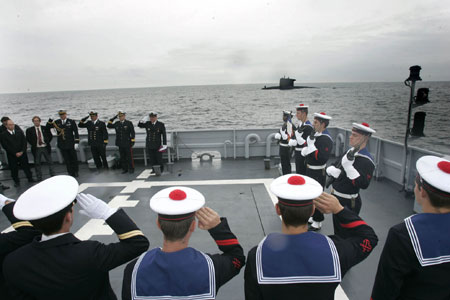
The ceremory aboard the Pluvier, Dutch submarine Dolfijn in the background
It was a very emotional ceremony and very impressive for us. Hans and I also dropped flowers in the water and we also paid our respects to them. We were interviewed by both Dutch and French television and some journalists from newspapers were present as well. On November the 27th we were invited by the French navy to come to Brest, one of the French Navy stations. They hold a big ceremony every year for all those French submariners who were killed in action during WW2.
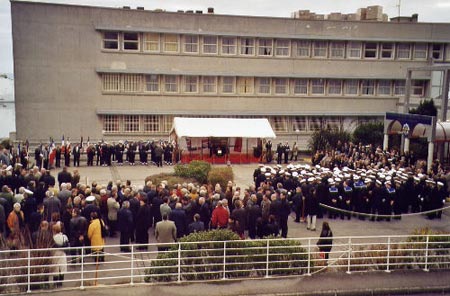
From the ceremony in Brest
On Saturday morning we went to the church in the city; 600 people were there to commemorate all those who were killed. During the service there were some speakers who thanked us from their heart. Hans and I are not French speaking, but Lilliane Sylvestre, the granddaughter of Maurice Le Sceller, the first engineer, stood beside us with her husband and translated for us. This lady had searched for years on the Internet to find something about the disappearance of her grandfather and her prayers were finally answered when she found our adventure in a Dutch to French translated newspaper where we had told our story. Her reaction was very similar to the reaction of Horenburg's sister (on discovering U-869 off America in the 1990's) and we are very pleased to see it make her happy. At that time, she was the only known relative of the Doris victims. After the service we walked to the Naval Monument for a big ceremony. After all this all the people who had something to do with Doris stepped into buses to go to the naval center on the other side of town. Hans and I went there by car with Lilliane and her husband.
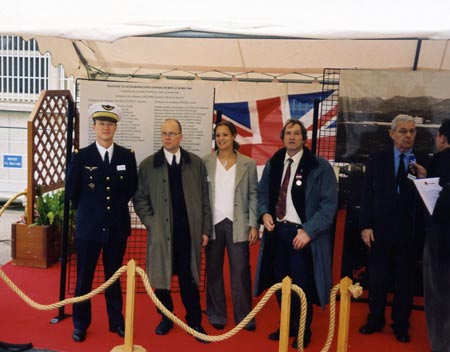
From left: Cyrille Aubry, a grandson of a crewmember, the author Ton van der Sluijs, Lilliane Sylvestre, the granddaughter of Maurice LeSceller and Hans van Leeuwen (who discovered Doris with Ton).
French television had broadcast the July 16th ceremony and 28 families of the victims must have gotten a shock at that moment because that was the first they had heard about it. In the hotel, the evening before the ceremony in Brest, a French lieutenant came to tell us that there was a special ceremony for Doris and she told us that 28 families were going to be present the next day. She also told us that there were two spots marked on the place were the ceremony would be held where we should stand. She told us that both of us were getting a medal! We were very surprised; that idea didn't come up in our wildest fantasies!
When we arrived at the spot where the Doris ceremony was held we found that the gun had been placed on a stand with a tent erected above it. All the relatives (28 families with a total of 130 members) together with 200 navy officials were there. At a certain moment a big limousine stopped and Grand Admiral Battet stepped out of the car and took his place in front of all the other navy officials. Mr. Favreul, the son of commander Favreul gave a speech (in French of course) and after 10 minutes Grand Admiral Battet did the same. We didn't understand a word, but at that moment eyes do tell more than enough.
After his speech we were asked to come to the middle of the square and then he gave us both the medal "Pour le Merite". They told us, we are the first foreigners who obtained this bronze treasure out of the hands of the French navy!
There was also time for French television and the newspapers to interview us and when this was finished all the people went into the navy restaurant for a snack and a drink together. When we went into the restaurant we met all the relatives and the navy men that were there as well. It was a very emotional meeting, even for us. Old men with tears in their eyes grabbed our hands and thanked us from the bottom of their heart; old ladies kissed us on the cheek while the tears were rolling down their own cheeks. There were even 6 widows from the victims of Doris.
I can tell you people this; I would do it all over again if we find another unknown wreck.
The wreck of Doris
When you get down to the wreckage, you see a field of debris around her. Where once an engine room was all you find now is an empty hole; the two torpedos hit her there and the torpedos in the stern tubes must have been detonated as well. The captain of the minesweeper Cassiopee told us that their sonar showed remains of the engine room 2 meters under the sand; for us it's an empty spot. Seven meters behind the end of the wreckage of the conning tower there is nothing left that you can see with your own eyes. Two meters in front of the tower on the port side we found the deck gun; she is now a monument at the naval base in Brest. Three meters to the starboard side lays the first torpedo launcher; the other one is 7 meters from the front on the starboard side. A deck winch which once was situated above the engine room now lies at the bow's end and a lot of smaller debris is scattered all over the place.
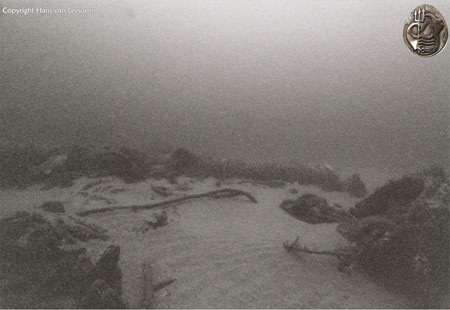
The wreck of Doris
I try to keep other divers away by telling them the true story that Doris is not an interesting site for those who are hunting for artifacts; in fact after a quick swim you've seen it all. Here in Holland there are no dive clubs that have the equipment and resources to suction the sand out of the hull (as has happened to some of the U-boat off the US coast) so the remains of the crew shall stay there undisturbed.
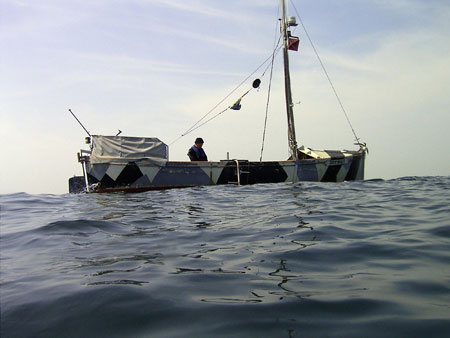
The 8.5 meter dive boat used to discover the Doris. She is painted in "Dazzled paint" as a tribute to the men who died on British destroyers HMS Ulleswater and HMS Scott during World War One. Ton and Hans dive those ships regularly.
This article was published on 10 Mar 2005.
